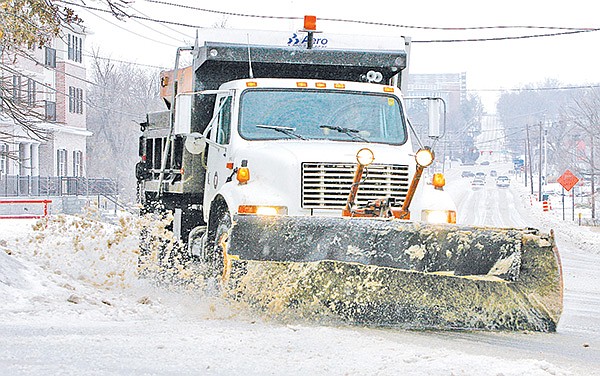Icy Weather Strains Northwest Arkansas Road Crews
An Arkansas Highway and Transportation Department snow plow clears School Street Tuesday morning in south Fayetteville. Northwest Arkansas received a wintry mix of rain, sleet and snow throughout the day.
Wednesday, February 5, 2014
Three waves of winter weather in as many months are pushing Northwest Arkansas road crews to their resources’ limits, which could hinder work in the near future, officials said Tuesday.
Thousands of tons of sand and gravel have been spread on streets alongside thousands of gallons of brine or beet juice to prevent ice. All of it cost tens of thousands of dollars in material and fuel as well.
The latest batch of winter weather began with about 5 inches of snow over the weekend and continued Tuesday with a mix of sleet, freezing drizzle and snow, which left main roads slushy but passable. Chances of light snow remain in the National Weather Service forecast through most of the week.
At A Glance
Tools Of The Trade
Grit/Gravel: Adds traction to ice or packed snow but does nothing to melt it. Washington County uses only limestone gravel — no salt.
Salt/Brine: Salt lowers ice’s melting point to about 15 degrees and is most effective if put down before freezing begins and isn’t washed away by rain or snowmelt.
Beet Juice: Used by several cities and the state, beet juice can amplify salt’s effects and push ice’s melting point to between zero and minus 25 degrees.
Source: Staff Report
“We have Sunday’s and then this round, and there’s just more coming,” Shawn Shrum, Washington County assistant road superintendent, said with a tired laugh.
City and county crews have been working around the clock, tackling more than 5,000 miles of roads in Washington and Benton counties with several dozen plows and graders.
Benton County’s Road Department had been working 18 hours a day since Sunday, Terry Nalley, the public services administrator, said Tuesday. During the night hours, he said, the department had an emergency crew on standby.
“That may be what we do again tonight,” he said. “To let the bulk of our crew go home and get some rest.”
All that work has burned through stockpiles of gravel, brine and beet juice. Several thousand tons of sand for Rogers will likely run out this week and might not be refilled any time soon, said Rogers Street superintendent Frankie Guyll.
“The companies can only get so much gravel at one time. Like sand, you can only harvest during the warmer months,” Guyll said. “When the sand runs out, we will have to start using quarter-inch gravel on the streets as last resort, and we only have about 500 pounds of that.”
Crews with Springdale, Fayetteville, Rogers and the state Highway and Transportation Department tried to prevent roads from being sealed in ice by spraying a mix of saltwater and beet juice. Salt compounds lower water’s freezing point to about 15 or 20 degrees, and the juice amplifies the effect, pushing it even below zero.
The layer of fluid helps prevent ice from freezing directly to concrete, said Sam Goade, Springdale Public Works director.
“This is about the fifth time we’ve pretreated, so we should be getting better at it,” Goade said.
Several tons of salt and juice were used, he added, with 50 tons more of salt and 1,000 gallons of juice expected to arrive this week.
The weather has taken a toll even on the plow and gravel trucks. Shrum said plow blades have to be replaced often. Two plow trucks were hit by other vehicles during the weekend causing minor damage.
The costs have proved a burden on some road department budgets. Guyll said his costs have eclipsed the $10,000 in his 2014 budget for winter weather. Fayetteville has spent $50,000 of its budgeted $90,000 for street-clearing efforts, which means money might need to be diverted from other transportation budget items.
Even on the state level, highway department spokesman Danny Straessle said regional suppliers of salt have struggled with demand, leading to higher costs, though he couldn’t provide specific dollar amounts.
Shrum, whose department uses limestone chips only, said he couldn’t be sure how much this wave of snow has cost because crews would submit their reports early next week. But it’s clear this week’s weather is better than the storm in early December, which dumped 7 inches of snow on top of a layer of ice.
That storm cost $70,000 to deal with, Shrum said, which is less than 1 percent of his department’s $9.5 million budget for 2013.
“The first storm, it just wouldn’t come off,” Shrum said, pointing to frigid temperatures and a lack of sunshine at the time. “At this point I think we’re fine.”
Several officials agreed their budgets were workable and the work needs to be done whatever the cost.
“We’ll continue plowing as long as necessary,” Guyll said.
Steve Caraway, John Gore, Mike Jones and Joel Walsh contributed to this report.
